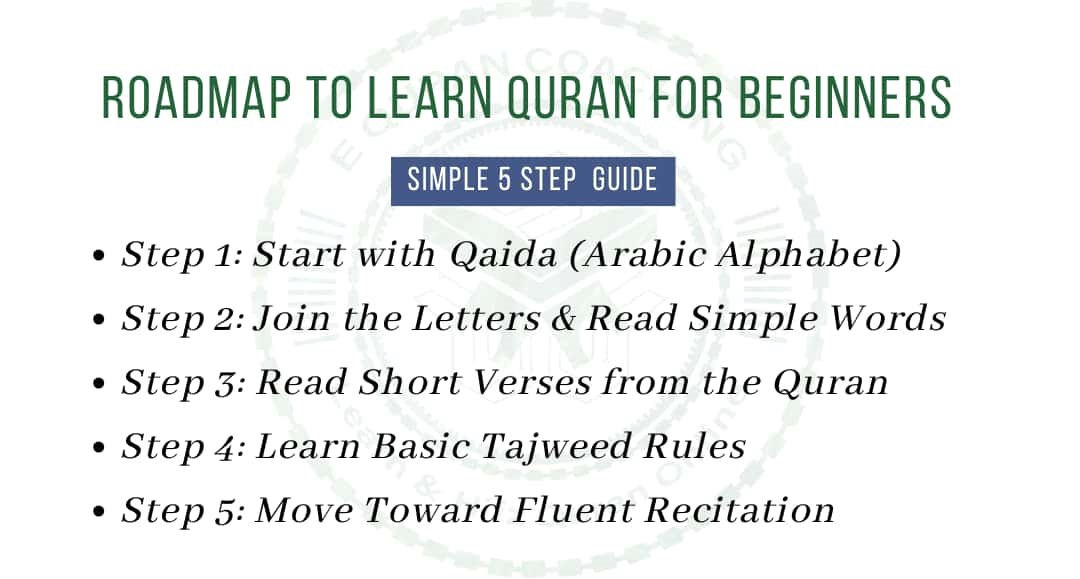Learning to read the Quran can seem overwhelming at first, especially for beginners or parents guiding their children. But with the right steps, consistency, and support, anyone can start this journey and progress steadily. Here's a clear, easy-to-follow roadmap for an easy way to learn Quran for beginners from scratch.
Step 1: Start with Qaida (Arabic Alphabet)
What is Qaida?
Qaida is a beginner-friendly booklet that introduces Arabic letters, sounds, and pronunciation rules in a simple, progressive manner. This is the foundation of an easy way to learn Quran for beginners.
What You'll Learn:
- Recognition of Arabic letters (in different shapes)
- Basic vowels (Fatha, Kasra, Damma)
- Simple syllables and word formation
Tips:
- Practice daily for 20–30 minutes
- Use audio support or an online tutor for pronunciation
- Stay patient—this stage builds the foundation
Estimated Time:
2–3 months (depending on consistency)

Step 2: Join the Letters & Read Simple Words
Key Focus Areas:
- Letter connections (beginning, middle, end forms)
- Reading small 2–3 letter words
- Recognizing basic harakat (vowel symbols) in context
Practice Activities:
- Read from advanced sections of Qaida
- Sound out words slowly, then increase speed
Estimated Time:
1–2 months
Step 3: Read Short Verses from the Quran
Start With:
- Surah Al-Fatiha
- Short surahs from Juz Amma (e.g., Al-Ikhlas, An-Nas, Al-Falaq)
Focus Points:
- Apply what you've learned in Qaida
- Practice reciting verse by verse
- Repeat each verse multiple times until fluent
Tip:
Don't worry about understanding meanings just yet. The focus here is accurate reading.
Estimated Time:
2–3 months
Step 4: Learn Basic Tajweed Rules
Why It Matters:
Proper Tajweed makes your recitation beautiful and correct. It's not just about sounding nice—it's about fulfilling your duty to recite the Quran accurately.
Basic Rules to Start With:
- Noon Sakin and Tanween (e.g., Ikhfa, Idgham)
- Meem Sakin (e.g., Idgham Shafawi)
- Madd (elongation)
- Qalqalah (echoing sound)
How to Learn:
- Study one rule at a time
- Practice using examples from the Quran
- Get regular correction from a qualified teacher or tutor
Estimated Time:
6–9 months for basics
Step 5: Move Toward Fluent Recitation
What It Involves:
- Daily recitation and revision
- Listening to skilled reciters
- Advanced Tajweed application
- Possibly memorizing selected surahs
Tips:
- Set a regular schedule with our Quran Planner
- Track your progress
- Don't rush—mastery takes time
Estimated Time:
Ongoing
How Parents Can Support Their Children
- Be involved: Sit with your child during lessons
- Use visuals: Charts, stickers, and apps can motivate
- Set goals: Small goals with mini-rewards help maintain momentum
- Lead by example: Children copy what they see
Why Online Learning is a Great Option
Benefits:
- Flexible scheduling
- One-on-one attention
- Learn from home
- Recorded sessions for revision
Especially for busy parents or those in non-Muslim countries, online learning provides an easy way to learn Quran for beginners by removing many barriers.
Final Thoughts
Learning to read the Quran is a journey, not a race. Whether you're helping your child or learning for yourself, take it one step at a time. Start with the basics, stay consistent, and don't hesitate to seek help when needed. This easy way to learn Quran for beginners has helped thousands of students worldwide.
With dedication and the right support, every beginner can become a confident Quran reader using this proven method, InshaAllah.